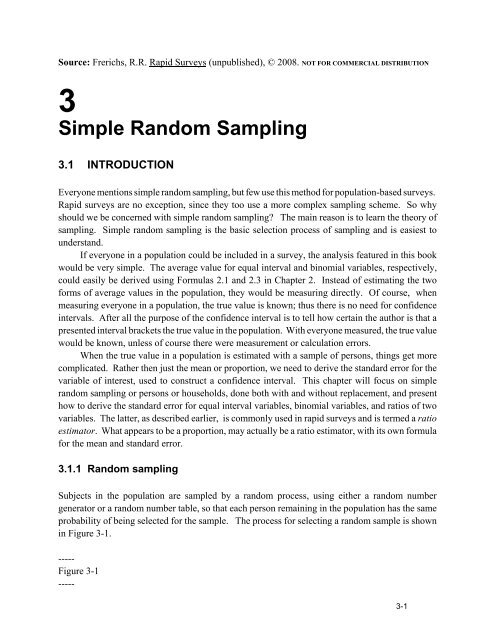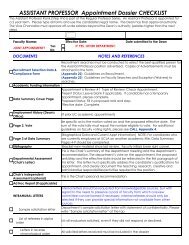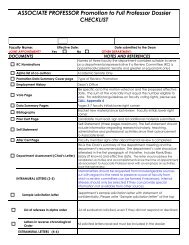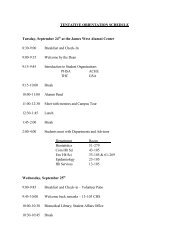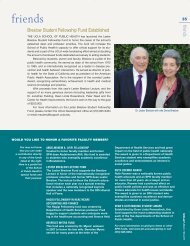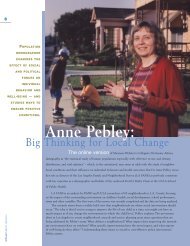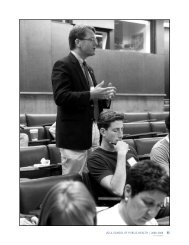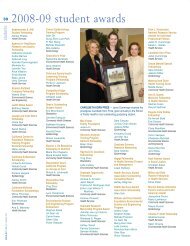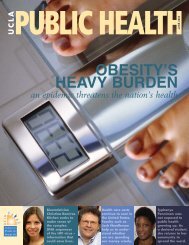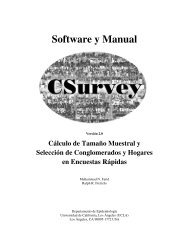3 Simple Random Sampling
3 Simple Random Sampling
3 Simple Random Sampling
Create successful ePaper yourself
Turn your PDF publications into a flip-book with our unique Google optimized e-Paper software.
Source: Frerichs, R.R. Rapid Surveys (unpublished), © 2008. NOT FOR COMMERCIAL DISTRIBUTION<br />
3<br />
<strong>Simple</strong> <strong>Random</strong> <strong>Sampling</strong><br />
3.1 INTRODUCTION<br />
Everyone mentions simple random sampling, but few use this method for population-based surveys.<br />
Rapid surveys are no exception, since they too use a more complex sampling scheme. So why<br />
should we be concerned with simple random sampling? The main reason is to learn the theory of<br />
sampling. <strong>Simple</strong> random sampling is the basic selection process of sampling and is easiest to<br />
understand.<br />
If everyone in a population could be included in a survey, the analysis featured in this book<br />
would be very simple. The average value for equal interval and binomial variables, respectively,<br />
could easily be derived using Formulas 2.1 and 2.3 in Chapter 2. Instead of estimating the two<br />
forms of average values in the population, they would be measuring directly. Of course, when<br />
measuring everyone in a population, the true value is known; thus there is no need for confidence<br />
intervals. After all the purpose of the confidence interval is to tell how certain the author is that a<br />
presented interval brackets the true value in the population. With everyone measured, the true value<br />
would be known, unless of course there were measurement or calculation errors.<br />
When the true value in a population is estimated with a sample of persons, things get more<br />
complicated. Rather then just the mean or proportion, we need to derive the standard error for the<br />
variable of interest, used to construct a confidence interval. This chapter will focus on simple<br />
random sampling or persons or households, done both with and without replacement, and present<br />
how to derive the standard error for equal interval variables, binomial variables, and ratios of two<br />
variables. The latter, as described earlier, is commonly used in rapid surveys and is termed a ratio<br />
estimator. What appears to be a proportion, may actually be a ratio estimator, with its own formula<br />
for the mean and standard error.<br />
3.1.1 <strong>Random</strong> sampling<br />
Subjects in the population are sampled by a random process, using either a random number<br />
generator or a random number table, so that each person remaining in the population has the same<br />
probability of being selected for the sample. The process for selecting a random sample is shown<br />
in Figure 3-1.<br />
-----<br />
Figure 3-1<br />
-----<br />
3-1
The population to be sampled is comprised of nine units, listed in consecutive order from one<br />
to nine. The intent is to randomly sample three of the nine units. To do so, three random numbers<br />
need to be selected from a random number table, as found in most statistics texts and presented in<br />
Figure 3-2. The random number table consists of six columns of two-digit non-repeatable numbers<br />
listed in random order. The intent is to sample three numbers between 1 and 9, the total number in<br />
the population. Starting at the top of column A and reading down, two numbers are selected, 2 and<br />
5. In column B there are no numbers between 1 and 9. In column C the first random number in the<br />
appropriate interval is 8. Thus in our example, the randomly selected numbers are 2, 5 and 8 used<br />
to randomly sample the subjects in Figure 3-1. Since the random numbers are mutually exclusive<br />
(i.e., there are no duplicates), each person with the illustrated method is only sampled once. As<br />
described later in this chapter, such selection is sampling without replacement.<br />
-----<br />
Figure 3-2<br />
-----<br />
<strong>Random</strong> sampling assumes that the units to be sampled are included in a list, also termed a<br />
sampling frame. This list should be numbered in sequential order from one to the total number of<br />
units in the population. Because it may be time-consuming and very expensive to make a list of the<br />
population, rapid surveys feature a more complex sampling strategy that does not require a complete<br />
listing. Details of this more complex strategy are presented in Chapters 4 and 5. Here, however,<br />
every member of the population to be sampled is listed.<br />
3.1.2 Nine drug addicts<br />
A population of nine drug addicts is featured to explain the concepts of simple random sampling.<br />
All nine addicts have injected heroin into their veins many times during the past weeks, and have<br />
often shared needles and injection equipment with colleagues. Three of the nine addicts are now<br />
infected with the human immunodeficiency virus (HIV). To be derived are the proportion who are<br />
HIV infected (a binomial variable), the mean number of intravenous injections (IV) and shared IV<br />
injections during the past two weeks (both equal interval variables), and the proportion of total IV<br />
injections that were shared with other addicts. This latter proportion is a ratio of two variables and,<br />
as you will learn, is termed a ratio estimator.<br />
-----<br />
Figure 3-3<br />
-----<br />
The total population of nine drug addicts is seen in Figure 3-3. Names of the nine male addicts<br />
are listed below each figure. The three who are infected with HIV are shown as cross-hatched<br />
figures. Each has intravenously injected a narcotic drug eight or more times during the past two<br />
weeks. The number of injections is shown in the white box at the midpoint of each addict. With<br />
one exception, some of the intravenous injections were shared with other addicts; the exact number<br />
is shown in Figure 3-3 as a white number in a black circle.<br />
Our intention is to sample three addicts from the population of nine, assuming that the entire<br />
population cannot be studied. To provide an unbiased view of the population, the sample mean<br />
3-2
should on average equal the population mean, and the sample variance should on average equal the<br />
population variance, corrected for the number of people in the sample. When this occurs, we can<br />
use various statistical measures to comment about the truthfulness of the sample findings. To<br />
illustrate this process, we start with the end objective, namely the assessment of the population mean<br />
and variance.<br />
Population Mean. For total intravenous drug injections, the mean in the population is derived using<br />
Formula 3.1<br />
where X i is the total injections for each of the i addicts in the population and N is the total number<br />
of addicts. Thus, the mean number of intravenous drug injections in the population shown in Figure<br />
3-3 is<br />
or 10.1 intravenous drug injections per addict.<br />
Population Variance. Formula 3.2 is used to calculate the variance for the number of intravenous<br />
drug injections in the population of nine drug addicts.<br />
where σ 2 is the Greek symbol for<br />
the population variance, Xi and N are as defined in Formula 3.1 and is the mean number of<br />
intravenous drug injections per addict in the population. Using Formula 3.2, the variance in the<br />
population is<br />
Sample Mean. Since the intent is to make a statement about the total population of nine addicts,<br />
a sample of three addicts will be drawn, and their measurements will be used to represent the group.<br />
3-3<br />
(3.1)<br />
(3.2)
The three will be selected by simple random sampling. The mean for a sample is derived using<br />
Formula 3.4.<br />
where x i is the number of intravenous<br />
injections in each sampled person and n is the number of sampled persons. For example, assume<br />
that Roy-Jon-Ben is the sample. Roy had 12 intravenous drug injections during the past two weeks<br />
(see Figure 3-3), Jon had 9 injections and Ben had 10 injections. Using Formula 3.4,<br />
the sample estimate of the mean number of injections in the population (seen previously as 10.1) is<br />
10.3.<br />
Sample Variance. The variance of the sample is used to estimate the variance in the population<br />
and for statistical tests. Formula 3.5 is the standard variance formula for a sample.<br />
where s2 is the symbol for the<br />
sample variance, xi is the number of intravenous injections for each of the i addicts in the sample<br />
and is the mean intravenous drug injections during the prior week in the sample. For the sample<br />
Roy-Jon-Ben with a mean of 10.3, the variance is<br />
3.2 WITH OR WITHOUT REPLACEMENT<br />
There are two ways to draw a sample, with or without replacement. With replacement means that<br />
once a person is selection to be in a sample, that person is placed back in the population to possibly<br />
be sampled again. Without replacement means that once an individual is sampled, that person is not<br />
placed back in the population for re-sampling. An example of these procedures is shown in Figure<br />
3-4 for the selection of three addicts from a population of nine. Since there are three persons in the<br />
sample, the selection procedure has three steps. Step one is the selection of the first sampled subject,<br />
3-4<br />
(3.4)<br />
(3.5)
step two is the selection of the second sampled subject and step three is the selection of the third<br />
sampled subject. In sampling with replacement (Figure 3-4, top), all nine addicts have the same<br />
probability of being selected (i.e., 1 in 9) at steps one, two and three, since the selected addict is<br />
placed back into the population before each step. With this form of sampling, the same person could<br />
be sampled multiple times. In the extreme, the sample of three addicts could be one person selected<br />
three times.<br />
-----<br />
Figure 3-4<br />
-----<br />
In sampling without replacement (WOR) the selection process is the same as at step one )<br />
that is each addict in the population has the same probability of being selected (Figure 3-4, bottom).<br />
At step two, however, the situation changes. Once the first addict is chosen, he is not placed back<br />
in the population. Thus at step two, the second addict to be sampled comes from the remaining eight<br />
addicts in the population, all of whom have the same probability of being selected (i.e., 1 in 8). At<br />
the third step, the selection is derived from a population of seven addicts, with each addict having<br />
a probability of 1 in 7 of being selected. Once the steps are completed, the sample contains three<br />
different addicts. Unfortunately, the reduced selection probability from the first to the third step is<br />
at odds with statistical theory for deriving the variance of the sample mean. Such theory assumes<br />
the sample was selected with replacement. Yet in practice, most simple random samples are drawn<br />
without replacement, since we want to avoid the strange assumption of one person being tallied as<br />
two or more. To resolve this disparity between statistical theory and practice, the variance formulas<br />
used in simple random sampling are changed somewhat, as described next.<br />
3.2.1 Possible samples With Replacement.<br />
When drawing a sample from a population, there are many different combinations of people that<br />
could be selected. Formula 3.6 is used to derive the number of possible samples drawn with<br />
replacement,<br />
where N is the number in the total population and n is the number of units being sampled. For<br />
example when selecting three persons from the population of nine addicts shown in Figure 3-3, the<br />
sample could have been Joe-Jon-Hall, or Sam-Bob-Nat, or Roy-Sam-Ben, or any of many other<br />
combinations. To be exact, in sampling with replacement from the population shown in Figure 3.3,<br />
there are<br />
or 729 different combinations of three addicts that could have been selected.<br />
3-5<br />
(3.6)
-----<br />
Figure 3-5<br />
-----<br />
The frequency distribution of the mean number of IV drug injections of the 729 possible samples<br />
selected with replacement is shown in the top section of Figure 3-5. Notice that the distribution has<br />
a bell shape, similar to a normal curve. There are three notable features of these 729 possible<br />
samples.<br />
Notable feature one. While the range of the 729 possible sample means is from a low of 8 to a high<br />
of 12, the average value of the sample means for the intravenous drug injections during the prior<br />
week is 10.1, the same as the population mean calculated previously with Formula 3.1. That is,<br />
when sampled with replacement, on average the sample mean provides an unbiased estimate of the<br />
population mean.<br />
Notable feature two. The average variance of the 729 possible samples of three selected with<br />
replacement is equal to the population variance of the nine drug addicts (see Formula 3.2), as shown<br />
in Formula 3.7<br />
where is the variance of sample i, where i goes from 1 to 729, the total number of possible<br />
samples when selecting three from nine with replacement.<br />
Notable feature three. For random samples of size n selected from an underlying population with<br />
replacement, the variance of the mean of all possible samples is equal to the variance of the<br />
underlying population divided by the sample size. For the 729 possible samples, the average<br />
variance of the mean for a sample of three from an underlying population of nine is shown in<br />
Formula 3.8.<br />
Thus with this form of sampling, on average the variance of the sample mean provides an unbiased<br />
estimate of the variance of the population divided by the sample size.<br />
Given these three features – namely that the mean, sample variance, and variance of the sample<br />
mean are unbiased estimators of the mean, population variance, and variance of the population<br />
3-6<br />
(3.7)<br />
(3.8)
divided by the sample size – it would seem that sampling with replacement is very useful. But is<br />
such sampling usually done?<br />
Without Replacement. In the realistic world of sampling, subjects are typically not included in<br />
the sample more than once. Also, the order in which subjects are selected for a survey is not<br />
important (that is, Roy-Sam-Ben is considered the same as Sam-Ben-Roy). All that matters is if the<br />
subject is in or out of the sample. Hence in most surveys, samples are selected disregarding order<br />
and without replacement. But does sampling without replacement provide unbiased estimators of<br />
the population mean and variance? The answer is “yes,” but needing some additional<br />
modifications, to be presented next.<br />
Formula 3.9 is used to calculated the number of possible samples that can be drawn without<br />
replacement, disregarding order,<br />
where N is the number of people in the population, n is the number of sampled persons, and ! is the<br />
factorial notation for the sequential multiplication of a number times a number minus 1, continuing<br />
until reaching 1. That is, N! (termed "N factorial") is N times N-1 times N-2 and the like with the<br />
last number being 1.<br />
In our example, we are selecting without replacement and disregarding order a sample of<br />
three addicts from a population of nine addicts (see Figure 3-3). Using Formula 3.9, we find there<br />
are<br />
or 84 possible samples. Fortunately when using Formula 3.9, all factorial numbers do not have to<br />
be multiplied. For example, the 9! in the numerator can be converted to 9 x 8 x 7 x 6!, and the 3! x<br />
(9-3)! in the denominator can be converted to 3 x 2 x 1 x 6!. By dividing 6! in the numerator by 6!<br />
in the denominator to get 1, the formula is reduced to 9 x 8 x 7 divided by 3 x 2 x 1 or 84 possible<br />
samples.<br />
The distribution of all possible sample means for the 84 samples selected with replacement,<br />
disregarding order in shown in the bottom section of Figure 3-5, below the distribution of the 729<br />
possible sample means selected with replacement. Are the two distributions similar? It is hard to<br />
tell since the scale does not permit an easy visual comparison. Figure 3-6 shows the same two<br />
distributions, but as a percentage of the total number of possible samples (i.e., 729 with replacement<br />
and 84 without replacement).<br />
-----<br />
Figure 3-6<br />
-----<br />
3-7<br />
(3.9)
There are two things to notice. First, the mean of all possible samples selected with replacement<br />
(i.e., 10.1) is equal to the mean of all samples selected without replacement, and both sample means<br />
are equal to the population mean. Thus, the sample mean on average remains an unbiased estimator<br />
of the population mean when sampling without replacement. Second, the percentage distributions<br />
of those selected with and without replacement are similar in shape, but there are fewer outlying<br />
samples among those sampled without replacement. That is, there is less variability among the 84<br />
possible samples selected without replacement than the 729 possible samples selected with<br />
replacement. The reduced variability in sampling without replacement is addressed in two ways,<br />
namely with a change in the variance formula for the population variance and in the addition of a<br />
finite population correction factor (FPC).<br />
First, different from Formula 3.2, the population variance that is being estimated by the sample<br />
variance when sampling without replacement has a different denominator (N-1), as shown in<br />
Formula 3.10.<br />
(3.10)<br />
where S2 is the modified<br />
population variance and Xi, N and are as defined previously. For the population of nine drug<br />
addicts, the modified variance is<br />
When sampling without replacement the average variance of all 84 possible samples is equal to the<br />
modified population variance (see Formula 3.11).<br />
(3.11)<br />
2<br />
where si is the variance in<br />
sample i, with i going from 1 to 84, the total number of possible samples when selecting three from<br />
nine without replacement.<br />
Second, the variance of the sample mean of all 84 possible samples when sampling without<br />
replacement is equal to the modified population variance divided by the sample size (as mentioned<br />
in notable feature three in sampling with replacement) times a correction factor that accounts for<br />
the shrinkage in variance. This correction factor, termed the finite population correction (FPC) is<br />
shown in Formula 3.12.<br />
3-8
(3.12)<br />
where N is the size of the population and n is the size of the sample. In samples where the sample<br />
size is large in relation to the population (an example being a sample of three from a population of<br />
nine), the FPC reflects the reduction in variance that occurs when sampling without replacement<br />
(i.e., with 84 possible samples in the example) compared to sampling with replacement (i.e., with<br />
729 possible samples in the example). This reduction in variability when sampling without<br />
replacement was observed in Figure 3.6, and in the comment that there were fewer outliers in the<br />
without replacement group.<br />
For the 84 possible samples, the average variance of the mean for a sample of three from an<br />
underlying population of nine is shown in Formula 3.13.<br />
(3.13)<br />
Notice that n/N is the fraction of the population that is sampled. Therefore the FPC is often<br />
described by sampling specialists as "one minus the sampling fraction." Notice also that the<br />
variance of the average samples mean is 0.36 for sampling without replacement compared to 0.48<br />
(see Formula 3.8) when sampling with replacement, resulting in smaller estimates of sampling error<br />
and greater efficiency in the sampling process when the sampling fraction is large. Finally, note that<br />
if the sampling fraction is very small, as occurs in typical rapid surveys of few persons drawn from<br />
a large population, then the finite population FPC term reduces to approximately 1, and is no longer<br />
needed.<br />
In summary, when sampling without replacement (i.e., the more practical and typical form of<br />
sampling) there are also three notable features, related but not entirely the same as stated earlier in<br />
the section on sampling with replacement.<br />
Notable feature one. When sampled without replacement, on average the sample mean provides<br />
an unbiased estimate of the population mean. This feature is the same whether sampling with or<br />
without replacement.<br />
Notable feature two. The average variance of all possible samples selected without replacement is<br />
equal to the modified population variance (i.e., N -1 rather than N in the denominator as when<br />
sampling with replacement – see Formula 3.2 versus 3.10).<br />
Notable feature three. For random samples of size n selected without replacement from an<br />
underlying population, the variance of the mean of all possible samples is equal to the modified<br />
variance of the underlying population divided by the sample size, multiplied by the finite population<br />
correction (FPC) factor.<br />
These three features account for the ability on average of samples selected with replacement<br />
to truthfully describe an underlying population, and to provide statistical measures of random error<br />
in the sampling process.<br />
In conclusion, what has been presented so far is that when drawing a simple random sample<br />
3-9
from a population, the selected sample is only one among many possible samples. Yet if the sample<br />
is selected in an unbiased manner, the average value of all possible samples is the same as the true<br />
value in the population. Since the true value is not know and only one sample is being selecting,<br />
the variability in the sampling process needs to be described, providing a measure of possible<br />
random error. Finally, when sampling without replacement the variability of all possible sample<br />
means is less than the variability of the sample means when selecting samples with replacement,<br />
especially when the sampling fraction is large. This reduction in variance is accounted for by the<br />
FPC term and results in greater efficiency in the sampling process, but only when the sampling<br />
fraction is large. As mentioned in Chapter 2, we will be using formulas that describe the variability<br />
of all possible samples to derive a confidence interval for the sample mean or proportion.<br />
In the following sections we will continue to sample three addicts, again drawn without<br />
replacement from a population of nine addicts. This time, however, a more extensive set of<br />
formulas will be used to calculate the mean and variance of two equal interval variables, a binomial<br />
variable and a ratio estimator.<br />
3.3 AVERAGE VALUE AND STANDARD ERROR<br />
Every population to be sampled has a true value for the variable of interest. A sample is drawn from<br />
the population to estimate this true value. This sample could be viewed as a selection of units from<br />
a population of units. Or it could be viewed as the selection of one sample from a population of all<br />
possible samples. In this section, we will determine the distribution of all possible samples for four<br />
variables: total injections, shared injections, HIV infection, and the ratio of shared to total<br />
injections. We will derive the mean, standard error and confidence interval for all possible samples<br />
of three addicts sampled without replacement from the nine addicts (see Figure 3-3). Since the<br />
sample is drawn without replacement, there are 84 possible samples.<br />
3.3.1 Equal Interval Data<br />
Each addict in the population of nine injected himself with drugs multiple times during the past two<br />
weeks. Some of the injections were shared with other addicts. The total number of injections and<br />
the number of shared injections are both equal interval variables, as described in Chapter 2.<br />
Different from binomial variables, equal intervals variables have many outcomes ranging in equal<br />
intervals from 0 to the upper end of a scale.<br />
Total Injections. The first of the two equal interval variables to be analyzed is total intravenous<br />
drug injections. The data are shown in white squares for each addict in Figure 3-3. As noted using<br />
Formula 3.1, the mean number of intravenous injections per addict in the population of nine drug<br />
addicts is<br />
3-10
or 10.1 injections per addict. The distribution of the total injections in the population of nine addicts<br />
is shown in Figure 3-7.<br />
-----<br />
Figure 3-7<br />
-----<br />
With the small population of nine, there are 84 possible samples of three addicts that could be<br />
selected, assuming sampling without replacement and disregarding order. To be derived for each<br />
possible sample are the mean for total injections (termed variable x) , the standard error of the mean<br />
and the confidence interval for total injections. The mean of each of the 84 possible samples is<br />
calculated with Formula 3.4. The one sample of Joe-Hal-Roy serves as an example.<br />
-----<br />
Figure 3-8<br />
-----<br />
The distribution of the 84 possible sample means is shown in the upper left of Figure 3-8. The<br />
average value of the 84 possible sample means is 10.1, the same as the mean for the total population<br />
of nine addicts (see Figure 3-7). Thus, the sampling scheme for total injections is considered<br />
unbiased. Observe, however, that some of the possible sample means had values as low as 9<br />
injections while others had values as high as 11.5 injections. By chance alone we could have<br />
selected one of these outlying samples, even though the sampling scheme is unbiased.<br />
The top right of Figure 3-8 shows the distribution of the standard errors of 84 sample means.<br />
To calculate each standard error, the variance of the sample mean is derived using Formula 3.14.<br />
(3.14)<br />
As noted earlier, the term (N-n)/N in Formula 3.14 is the finite population correction, included only<br />
because this is a sample selected without replacement. For the sample Joe-Hal-Roy, the variance<br />
of the sample mean is<br />
The standard error of the total injections, , is the square root of the variance, , as shown<br />
in Formula 3.15.<br />
3-11
For the sample Joe-Hal-Roy, the standard error is<br />
A confidence interval can be created for each of the 84 possible samples using Formula 3.16.<br />
(3.15)<br />
(3.16)<br />
where is as defined previously and t is the value of Student’s t that corresponds to a specified<br />
level of confidence (usually 95%) and a sample size of three. But why use a t-value when<br />
confidence intervals are typically derived with z-values, also termed the “standard normal deviate?”<br />
-----<br />
Figure 3-9<br />
-----<br />
The t-value is appropriate here because of the exceptionally small size of the sample. As<br />
observed in Figure 3-9, for a normal-sized simple random sample of 200 or more, the t-value is<br />
identical to the z-value. For a 95% confidence interval, the z-value is 1.96. Yet with a small sample<br />
of three, the t-value for a 95% confidence interval is 4.30, far greater than 1.96. Using Formula<br />
3.16, the 95% confidence interval for the mean of total injections of 10.0 estimated in the sample<br />
Joe- Hal-Roy is<br />
or a lower limit of 5.9 and an upper limit of 14.1.<br />
The 84 confidence intervals for all possible samples are shown in the bottom section of Figure<br />
3-8. Five of the 84 possible samples do not bracket the true value (marked with an asterisk at the<br />
bottom of the figure) , while 79 (i.e., 94%) do bracket the true value. Keep in mind that only one<br />
of the 84 possible samples is selected for the survey. Seventy-nine times out of 84, the constructed<br />
confidence interval will contain the true value. Thus in advance of sampling, we can be 94%<br />
confident that the interval we construct would contain the true value, assuming the sample was<br />
selected in an unbiased manner. If the sample and population had both been much larger, a 95%<br />
confidence interval using the z-value of 1.96 would have been constructed rather than the 94%<br />
confidence interval for 84 possible samples of three with the t-value of 4.30.<br />
Shared Injections. The second of the two equal interval variables is shared intravenous drug<br />
injections. Here the letter y is used to describe the statistics rather than x as with total injections.<br />
3-12
Both of these variables will be used in a subsequent section for calculating a ratio estimator. Thus<br />
they are identified with different letters, even though the mathematical calculations are identical.<br />
3-13
-----<br />
Figure 3-10<br />
-----<br />
The data for shared injections are shown in black circles in Figure 3-3, while the distribution<br />
of the shared injections in the population of nine addicts is shown in Figure 3-10.<br />
The population mean for the shared intravenous injections is calculated using Formula 3.17.<br />
(3.17)<br />
Here is the mean value of variable Y in<br />
the population, Y i is the value of variable Y in person i, N is the number of persons in the population<br />
. The mean number of shared intravenous injections per addict in the population of nine drug<br />
addicts is<br />
As before, there are 84 possible samples. For each is derived the mean, standard error of the<br />
mean and 95% confidence interval. The mean number of shared injections for each sample of three<br />
is calculated with Formula 3.18<br />
(3.18)<br />
where is the mean number of intravenous<br />
injections per addict in the sample, y i is the number of shared injections per sampled addict, and n<br />
is the number of sampled addicts. Continuing with the example of Joe- Hal- Roy, the mean number<br />
of shared injections is<br />
-----<br />
Figure 3-11<br />
-----<br />
3-14
The distribution of the 84 possible sample means is shown in the upper left of Figure 3-11.<br />
The average value of the 84 possible sample means is 3.0, identical to the mean for the total<br />
population of nine addicts. Thus, the sampling scheme for shared injections is unbiased. Of course,<br />
most of the 84 possible samples have mean values different from 3.0, although the average of all<br />
possible samples is the same as the true value of 3.0.<br />
The distribution of the standard errors of the 84 sample means is observed in the upper right<br />
of Figure 3-11. The standard errors are derived by first calculating the variance of the sample mean,<br />
v(¯y), using Formula 3.19.<br />
(3.19)<br />
The finite population correction, (N-n)/N, reduces the size of the variance when sampling without<br />
replacement. For the sample of Joe- Hal-Roy, the variance of the sample mean for shared injections<br />
is.<br />
The standard error of the total injections, , is the square root of the variance, . For the<br />
sample Joe-Hal-Roy, the standard error is the square root of 0.96 or 0.98.<br />
The confidence interval for the sample Joe- Hal- Roy for the mean of shared injections of 4.33<br />
is<br />
or a lower limit of 0.12 and an upper limit of 8.54. The 84 confidence intervals for all possible<br />
samples are shown in the bottom section of Figure 3-11. Five of the confidence intervals do not<br />
bracket the true value in the population and are marked with an asterisk. Since 79 (94%) of the 84<br />
possible samples do bracket the true value, the confidence limits in the small example population<br />
are actually for 94% confidence intervals. Of course for the one sample that we selected, we would<br />
not know if it is among the group of five that do not contain the true interval or 79 that do. After<br />
the sample is drawn and an interval is created, the probability is either 0 or 1 that the interval<br />
contains the true value. That is, the confidence interval either does or does not bracket the true<br />
value. Before the sample is drawn, however, we can be 94% confident that the interval to be<br />
calculated will bracket the true value. For larger samples and larger populations, the z-value of 1.96<br />
would be used instead to derive intervals which bracket the true value 95 percent of the time.<br />
3.3.2 Binomial Data<br />
3-15
The values for binomial data are derived in a similar manner to equal interval data, although the<br />
formulas appear slightly different. The binomial variable being considered is HIV infection, a<br />
variable with two outcomes, 0 if not infected and 1 if infected. In the population shown in Figure<br />
3-3, three of the nine addicts were infected with HIV. Using Formula 3.1, the mean HIV status in<br />
the population of nine drug addicts is<br />
or 0.33 as presented as a proportion or 33 as a percentage. The mean value of the variable HIV<br />
infection with an outcome of 0 or 1 is the same as the proportion who are HIV positive. That is, the<br />
mean of a binomial variable coded with a 0-1 outcome is the proportion with the attribute. The<br />
mean of a binomial variable is also defined as<br />
(3.20)<br />
where P is the proportion in the population, A is a count of those with the attribute of interest, and<br />
N is the number of units in the population. In our example, there are three HIV infected persons in<br />
a population of nine addicts. Thus the proportion in the population that is infected is 3/9 or 0.33.<br />
-----<br />
Figure 3-12<br />
-----<br />
The distribution of HIV status for the nine addicts is shown in Figure 3-12.<br />
When a binomial variable such as HIV status is coded 0 or 1, Formulas 3.1 and 3.20 are the<br />
same. If a binomial variable is coded 1 or 2, however, then the mean value derived with Formula<br />
3.1 will be different than the proportion calculated with Formula 3.20. For the mean of a binomial<br />
variable to appear as a proportion (or as a percentage if multiplied by 100), the outcome must be<br />
coded as 0 or 1, or tallied as a count of those with the attribute.<br />
Next we calculate the proportion that is infected with HIV for each of the 84 possible samples<br />
of three addicts. Formula 3.21 is used to calculate the proportion for each sample.<br />
(3.21)<br />
where p is the proportion that is HIV positive in the sample, a is the count of HIV infected persons<br />
in the sample, and n is the number of sampled addicts. Thus for the sample of Joe- Hal-Roy, the<br />
proportion that is HIV positive is<br />
3-16
If by chance this sample would have been selected, the estimate of the proportion who are HIV<br />
positive would have been twice the true value of 0.33.<br />
-----<br />
Figure 3-13<br />
-----<br />
The distribution of the 84 possible sample proportions is shown in the upper left of Figure 3-<br />
13. The average value of the 84 possible sample proportions is 0.33, the same as the proportion for<br />
the total population of nine addicts. When the average value of all possible samples is equal to the<br />
proportion (or mean for equal interval variables) in the population, we say that the sampling scheme<br />
is unbiased. Notice, however, that being unbiased does not imply that the proportion for the one<br />
sample being selected is the same as the proportion in the population. Instead being unbiased<br />
indicates that on average the sample proportion equals the population proportion. Also notice that<br />
some of the possible sample proportions had values as low as 0 while others had values as high as<br />
1. Thus by chance alone, the sample being selected could have a proportion far different from the<br />
true value of 0.33. In fact, only with 45 of the 84 possible samples was the point estimate of the<br />
proportion the same as the true value.<br />
Due to the small size of the population and even smaller size of the sample, the proportion in<br />
the example does not behave as would occur in a larger population and larger sample. Here 20 of<br />
the 84 possible samples have a value of 0 and 1 has a value of 1. The consequence of having a mean<br />
value of 0 or 1 will become apparent when calculating the variance, standard error and confidence<br />
intervals for the proportion, which follows next.<br />
The variance of a proportion for a simple random sample, selected without replacement, is<br />
calculated using Formula 3.22,<br />
(3.22)<br />
where v(p) is the variance of the sample proportion, p is the sample proportion, and n is the number<br />
of sampled addicts. For the sample of Joe- Hal-Roy, the variance of the proportion is<br />
The standard error of the sample proportion, is the square root of the sample variance, as<br />
shown in Formula 3.23.<br />
3-17<br />
(3.23)
For the sample Joe- Hal-Roy, the standard deviation is the square root of 0.074 or 0.272.<br />
With this example of a sample of three from a population of nine, Figure 3-13 shows that there<br />
are only four outcomes for the sample proportion, namely 0/3, 1/3, 2/3 or 3/3. For those 20<br />
possible samples with a proportion of 0, the variance of the proportion is the same as for the one<br />
sample with a proportion of 1, namely<br />
In both instances, with a variance of 0 the se(p) is 0. Thus for 21 of the 84 possible samples, the<br />
standard error of the proportion in the small example is 0. For the remaining 63 possible samples<br />
the proportion was either 1/3 or 2/3, both having the same variance.<br />
For these 63 possible samples, the standard error of the proportion is<br />
Thus with a sample of three from a population of nine, there are only two values for the se(p),<br />
namely 0 or 0.272, as shown in the upper right of Figure 3-13. Such limited values for a binomial<br />
variable do not occur when the population and samples are larger, as occurs with typical rapid<br />
surveys. Nevertheless, the example remains useful for demonstrating the calculations.<br />
Using the standard error, the confidence intervals are calculated for each of the 84 possible<br />
samples. The confidence interval is derived using Formula 3.24.<br />
(3.24)<br />
where p is the proportion, se(p) is the standard error and t is a statistic corresponding to the z-value<br />
with the sample is exceptionally small, as noted in Figure 3-9.<br />
To calculate 95% confidence intervals for each of the 84 possible samples, we use a t-value<br />
of 4.30, much larger than a z-value of 1.96 typically used with 95% confidence intervals. The<br />
confidence interval for the sample Joe- Hal-Roy with a proportion 0.67 is<br />
or a lower limit of 0 and an upper limit of 1. Unfortunately, because the sample of three is so small,<br />
3-18
the confidence interval is extremely wide, and hence is of little use, other than to demonstrate the<br />
calculations. The 84 confidence intervals are shown in the bottom of Figure 3-13. With such a<br />
small sample, most of the confidence intervals are very wide, extending from 0 to 1. In 21 of the<br />
84 samples the standard error was 0. For these 21 samples, the confidence interval did not bracket<br />
0.33, the true proportion in the population. The 21 samples are identified in Figure 3-23 with an<br />
asterisk. It is clear from viewing Figure 3-13 that for this small sample of three addicts drawn from<br />
a population of nine addicts, only a 75% confidence interval could be derived. That is in 63 times<br />
out of 84 (75%), the surveyor would be confident that the created interval brackets the true value.<br />
For larger surveys with billions and trillions of possible samples, 95% of the confidence intervals<br />
that would be derived using a z-value of 1.96 would bracket the true value in the sampled<br />
population, assuming there was no bias in the sample selection.<br />
3.3.3 Ratio Data<br />
What comes next is a different way of viewing the data, introduced earlier in Chapter 2. Rather that<br />
considering the mean number of injections or the mean number of shared injections, we will<br />
determine the proportion of injections that were shared. This proportion is actually a ratio of two<br />
random variables: shared injections (variable y) and total injections (variable x). Notice that the<br />
sample is of addicts, not injections. Thus the three addicts in the sample may have different numbers<br />
of shared injections (one variable) and of total injections (a second variable). Yet the sample is only<br />
comprised of three addicts. Later in this chapter you will learn the difference between the units that<br />
are sampled, given here as addicts, and the units that are analyzed, namely total and shared<br />
injections. The former are termed sampling units while the latter are elementary units.<br />
-----<br />
Figure 3-14<br />
-----<br />
When considering injections rather than people, the data can be viewed as in Figure 3-14. The<br />
ratio of the two variables “shared” to “total” is calculated with Formula 3.25.<br />
(3.25)<br />
where R is the ratio of variable Y to X in the population, Y i is the value of variable Y in person i, X i<br />
is the value of variable X in person i, N is the number of persons in the population, and G is the sum<br />
symbol indicating to add the values for each person from 1 to N.<br />
-----<br />
Figure 3-15<br />
3-19
-----<br />
As shown in Figure 3-15, there were 27 shared injections during the past two week and 91 total<br />
injections, for a true ratio in the population of 0.297. Notice that the ratio is given as a proportion,<br />
but a proportion of injections, not of people.<br />
The ratio of shared to total injections is calculated for each of the 84 possible samples using<br />
Formula 3.26.<br />
(3.26)<br />
For the sample Joe- Hal- Roy, the ratio estimator (that is, our estimate of the ratio) is calculated as<br />
Notice that this is an estimate of the proportion of injections that is shared. The number could also<br />
be multiplied times 100 to derive the percentage of injections that are shared (i.e., 43%).<br />
-----<br />
Figure 3-16<br />
-----<br />
The ratio for the 84 possible samples is shown in the upper left of Figure 3-16. Here the mean<br />
of all possible sample ratios is slightly different from the ratio in the total population. While the<br />
difference is small (that is, 0.297 in the population versus 0.296 in mean of all possible samples),<br />
there is a difference nevertheless. Ratio estimators may be slightly biased, so that the average of all<br />
possible samples is not the same as the true ratio in the population. When the sample size is larger,<br />
however, the bias becomes minimal. The issue of bias in ratio estimators will be further addressed<br />
later in this chapter.<br />
Next the variance of the ratio for each of the 84 possible samples will be calculated, followed<br />
by the standard errors and confidence intervals. The variance formula is different from those<br />
presented earlier. The formula will be presented here, but will await Chapter 5 to be discussed in<br />
more detail.<br />
(3.27)<br />
The finite population correction term in Formula 3.27 is (N-n)/N, the ratio in the sample is r, and<br />
3-20
the other terms are as previously defined. For the sample Joe-Hal-Roy, the variance of the sample<br />
ratio is<br />
The standard error of the ratio, se(r), is the square root of the variance, v(r) as shown in Formula<br />
3.28.<br />
(3.28)<br />
For the sample Joe-Hal-Roy, the standard error is the square root of 0.0055 or 0.074. The<br />
distribution of standard errors for all possible samples is shown in the upper right of Figure 3-16.<br />
The confidence interval for the ratio, CI(r), is derived using Formula 3.29.<br />
(3.29)<br />
where se(r) is the standard error and t is the t-value for the stated sample size. For the sample Joe-<br />
Hal-Roy, the confidence interval is..<br />
or a lower limit of 0.11 and an upper limit of 0.75. Confidence intervals for all 84 possible samples<br />
are shown in the lower section of Figure 3-16. The vertical axis with “Ratio (Shared/Total)” extends<br />
from a low of -0.4 to a high of 1.0, appropriate for a ratio but different from a proportion that goes<br />
from 0 to 1. While none of the point estimates of the sample ratios extend beyond 0 or 1, some of<br />
the confidence intervals do. This issue will be addressed in Figure 3-17. Also observe that 5 of the<br />
84 confidence intervals (6%) do not bracket the true value in the population. Thus 94% of the<br />
intervals enclosed the true value. The interpretation is that in advance of sampling, we can be 94%<br />
confident that intervals derived with Formula 3.29 would bracket the true value. With larger<br />
samples from larger populations, the confidence intervals created with Formula 3.29 , but using the<br />
z-value of 1.96, would bracket the true value 95 percent of the time, assuming of course that there<br />
was no bias in the sample selection.<br />
-----<br />
Figure 3-17<br />
-----<br />
3-21
When doing rapid surveys, the analysis is often of a ratio estimator appearing as a proportion.<br />
That is, the ratio estimator seems like a variable with values between 0 and 1, even though in reality<br />
the range could be much wider. Since the point estimate for a ratio estimator that acts like a<br />
proportion lies between 0 and 1, the problem lies with the confidence limits, both on the high and<br />
low end. Since a proportion above 1 or below 0 does not make sense, the range of the confidence<br />
limits in rapid surveys is typically truncated, as shown in Figure 3-17. Note that this truncation has<br />
no effect on the confidence that the presented intervals bracket the true ratio in the population.<br />
3.4 SAMPLES AND ELEMENTS<br />
In the example of drug addicts, the starting point was a population of nine addicts from which three<br />
addicts were randomly selected. The process of sampling to identify the prevalence of HIV<br />
infection is shown in Figure 3-18. In order to sample from the population of nine addicts, all must<br />
first be assembled in a list termed a frame. From this frame, three units are sampled. Each unit is<br />
termed a sampling unit while the group of sampling units is termed the sample. In Figure 3-18, the<br />
sampling unit is a drug addict and the sample is three addicts. The units to be analyzed, termed<br />
elementary units, are drug addicts (or persons) and are the same as the sampling units. The group<br />
of elementary units is referred to as elements. In this example, the sample is the same as the<br />
elements. That is, the group selected in the sample is the same as the group to be analyzed. In<br />
Figure 3-18, one addict is HIV positive and the other two are not. Thus the population prevalence<br />
(or proportion) is 1/3 or 0.33, the numerator being HIV infected addicts and the denominator being<br />
sampled addicts. Because a sample of three addicts was selected, the size of the denominator is<br />
fixed as three. In estimating HIV prevalence, the numerator varies from one possible sample to the<br />
next. That is, the denominator is fixed but the numerator is a random variable.<br />
-----<br />
Figure 3-18<br />
-----<br />
A slightly different situation is shown in Figure 3-19. Here the sample is also three addicts<br />
but the elements are nine injections. If the analysis is of the mean number of injections per addict<br />
or mean number of shared injections per addict, the derivation is the mean for an equal interval<br />
variable. While the denominator remains fixed at three addicts, the numerator varies from one<br />
possible sample to the next. That is, the numerator is a random variable, but not the denominator.<br />
-----<br />
Figure 3-19<br />
-----<br />
The elements can also be analyzed independent of the sample. Specifically, the number of<br />
shared injections can be related to the number of total injections. This is a proportion, but using<br />
injections rather than persons. The denominator of the proportion is the number of injections which<br />
varies from one sample to the next, depending which addicts were included. In this proportion both<br />
the numerator and denominator are random variables. As a result, the data are analyzed as a ratio<br />
estimator, or a ratio of one random variable to another.<br />
3-22
-----<br />
Figure 3-20<br />
-----<br />
So what happens when the simple random sample is of households rather than of persons? In<br />
Figure 3-20 there is a population of households. To sample from this population, the households<br />
are arranged in a list or frame and households are sampled randomly from the frame. For this<br />
example, the sample consists of 30 households, selected randomly from the population of many<br />
households. For the analysis, the interest is not in characteristics of the housing unit. Instead<br />
information is wanted about the about the household occupants, namely people. Thus the analysis<br />
is of elements in the households, although only households were sampled. For such a survey, the<br />
analysis is of a ratio estimator, or comparison of two random variables. The random variable in the<br />
denominator is the number of persons in the sampled households and the random variable in the<br />
numerator is the number of persons with the attribute being studied.<br />
3.5 SURVEY OF SMOKING BEHAVIOR<br />
In Section 3.3, the population to be sampled was addicts. Yet for one analysis ) shared to total<br />
injections ) the data were viewed as a ratio, although the results were presented as a proportion or<br />
percentage. You observed in Figure 3-16 that a confidence interval can be created for a ratio<br />
estimator, although in our small example, the interval for some of the possible samples was very<br />
wide. You also noted in Figure 3-16 that there was a small bias in the ratio with the average value<br />
of all possible samples (i.e., 0.296) being slightly different from the true value in the population (i.e.,<br />
0.297). This section will further explore ratio estimators, using a survey of smoking behavior to<br />
illustrate the various issues and principals.<br />
-----<br />
Figure 3-21<br />
-----<br />
3.5.1 Sample of Persons<br />
Before considering ratio estimators, assume that a sample of 90 persons was sampled by simple<br />
random selection from a population frame of 3,000 persons as shown in Figure 3-21. The intent<br />
is to determine the prevalence of current cigarette smoking behavior. Thus the sample units and<br />
elementary units are both persons and the outcome of the analysis is a binomial variable (i.e., smoker<br />
= 1, non-smoker = 0). In this population, 54% currently smoke. The sampling is done with<br />
replacement, discarding order. Thus using Formula 3.9, the number of possible samples of 90 from<br />
a population 3,000 is,<br />
3-23
a very large number of possible samples! For each of these possible, we could derive the mean,<br />
standard error and 95% confidence interval. Yet doing so would be a formidable task, and the<br />
certainly the results could not be viewed graphically. Instead, the population is replicated in a<br />
computer spreadsheet model, and 100 surveys of 90 persons each are randomly selected from the<br />
frame of all possible samples for graphic presentation. To derive the 95% confidence interval, the<br />
finite population correction term is included and a t-value of 1.986 is used instead of the z-value<br />
of 1.96 (see Figure 3-9, sample size of 90). The 95% confidence interval for each of the 100 surveys<br />
is derived as (see Formulas 3.22 and 3.24),<br />
with the 100 confidence intervals as shown in Figure 3-22.<br />
-----<br />
Figure 3-22<br />
-----<br />
Observe that the average standard error for the 100 surveys is 5.2% which in later discussion will<br />
be termed “medium variability.” The mean of the 100 samples was 53.1% smokers, nearly identical<br />
and within random statistical variation of the 54% who smoked in the total population. Also notice<br />
that five of the 100 confidence intervals did not bracket the true value of 54% in the population, as<br />
would be expected when deriving 95% confidence intervals. Figure 3-22 will serve as a<br />
comparison, when next we consider a household survey with elementary units different from<br />
sampling units.<br />
3.5.2 Sample of Households<br />
Assume that 30 households (HH) with an average of three persons per HH were drawn in a simple<br />
random sample from a population frame of 1,000 households. As previously shown in Figure 3-20,<br />
in such a survey the sampling unit of a household is different from the elementary unit of a person.<br />
In fact, in such surveys the people in a household are represented by two variables, the first being<br />
the existence of each person and the second being the smoking status of each person. Thus the<br />
proportion who smoke is derived as a ratio of two variables within the selected households, namely<br />
smoking status and existing persons, and as such is a ratio estimator. When analyzing a ratio<br />
estimator, a slightly different variance formula is used (similar to Formula 3.27), to be further<br />
explained in Chapter 5.<br />
3-24<br />
(3.30)
where N is the number of households in the population, n is the number of households in the sample,<br />
ai is the number who smoke in each household, p is the proportion who smoke in the total sample,<br />
mi is the number who exist in each household, and is the average number of persons per<br />
household.<br />
-----<br />
Figure 3-23<br />
-----<br />
Furthermore, the households in the population are of five occupancy sizes, as shown in Figure<br />
3-23. Each group in the population resides in 200 homes, and in the total population of 1,000<br />
households the average is three persons per household. Thus the simple random samples of persons<br />
and households have the same number of persons (i.e., 3,000), although in the household survey the<br />
people are distributed in 1,000 households.<br />
Because the household survey is a sample of 30 households from a population of 1,000<br />
households, the number of possible samples is not as great as in when doing a simple random sample<br />
of 90 persons from a population of 3,000 people. Again using Formula 3.9, the number of possible<br />
samples of 30 from a population 1,000 is,<br />
still a huge number of possible samples. As before with the simple random sample of persons, a<br />
computer spreadsheet model is used to randomly select and present 100 of the possible samples of<br />
30 households from the population of 1,000 households. The 95% confidence interval will again<br />
use a t-value instead of the z-value used in larger rapid surveys, but this time of 2.0452 (see Figure<br />
3-9, sample size is 30). The 95% confidence interval for each of the 100 household surveys is<br />
derived as (see Formulas 3.22 and 3.24),<br />
Variability of Smoking. Measures such as the variance, standard error and confidence interval<br />
provide a numeric assessment of the variability of smoking behavior in the population. In a simple<br />
random sample of persons, the variability is observed when comparing one individual to another.<br />
In contrast, the variability of persons in a simple random sample of households is expressed both<br />
within households by the smoking patterns of the people that occupy the household, and between<br />
households, comparing the proportion of residents who smoke in one households versus the others.<br />
-----<br />
Figure 3-24<br />
-----<br />
3-25
In Figure 3-22, the variability of the persons selected in a simple random sample was presented<br />
as 100 different 95% confidence intervals and summarized with the average standard error value of<br />
5.2%. This level of variation was termed “medium variability.” Figure 3-24 shows two situations<br />
where the distribution of smoking behavior is the same in the population of 3,000 persons (the top<br />
section) and in the 1,000 households (the bottom section). The only change in the bottom section<br />
is that households were placed around members of the population. Thus the people within<br />
households are as variable in their smoking patterns as in the population. Or restated, the chance<br />
of being a smoker within a household is independent of the smoking status of other members of the<br />
household. This may not seem logical given human behavior, but instead is used to illustrate a<br />
notion. Since the level of variability in the population of 3,000 persons and 1,000 households with<br />
an average of three persons per household is the same, the household surveys should also exhibit<br />
“medium variability.”<br />
-----<br />
Figure 3-25<br />
-----<br />
The distribution of smokers within each group of 200 households is shown in Figure 3-25. The<br />
figure is divided into four sections, each describing the population household distributions that is<br />
associated with different levels of smoking variability in random sample surveys. The first<br />
distribution to be considered is of medium variability in part B.<br />
Medium Variability. In this example, 54% of the population smokes. Assuming that people in<br />
small households are just as likely to smoke as people in large households, then the percent smokers<br />
in each of the five-sized households should also be 54%. Figure 3-25 B shows the distribution of<br />
smokers in households by household size, for household surveys in which the variability is the same<br />
as in a simple random sample of persons (i.e., medium variability).<br />
-----<br />
Figure 3-26<br />
-----<br />
When drawing 100 samples of 30 households from the billions of possible samples, the values<br />
of the 95% confidence intervals are presented in Figure 3-26 B. The dark horizontal line shows the<br />
true value in the population, or 54% smokers. Notice that the standard error of 5.1% is nearly<br />
identical to the standard error of 5.2% for the simple random sample (see Figure 3-22). The minor<br />
difference is due to random variation in the sampling process. The mean of the 100 samples is<br />
53.9%, very close to the true value of 54%. Finally, notice that six of the 100 confidence intervals<br />
in Figure 2-26 B do not bracket the true value of 54% smokers from this population, nearly the same<br />
as the five that would be expected by chance. If many more sets of 100 surveys would have been<br />
drawn from all possible samples, the percentage of 95% confidence intervals that do not bracket<br />
the true value would likely be in the 4-6 percent range, averaging 5 percent.<br />
So far we have considered the situation where the level of variability in a household survey<br />
(termed “medium” in magnitude) is identical to a random sample of persons in the population. What<br />
if this is not true? What if the variability in a household survey is greater or less than the variability<br />
of a survey of persons? To understand the variability of household surveys, we need next to<br />
3-26
consider variability both within households and between households.<br />
3.5.1 Variability Within and Between Households<br />
The variability of a binomial variable such as smoking is derived using variance formula for a<br />
proportion (see Formula 3.22). Leaving out the finite population correction term, the v(p) formula<br />
is reduced to<br />
This formula shows that for any given household size, the variance of the proportion who smoke is<br />
depended on the size of the numerator, namely p x q, distributed as shown in Figure 3-27 for fiveperson<br />
households.<br />
-----<br />
Figure 3-27<br />
-----<br />
The variance within a five-person household will be zero if either none of the occupants are smokers<br />
or if all of the occupants are smokers. Conversely, the variance within households will be largest<br />
if either two or three of the five household members are smokers.<br />
-----<br />
Figure 3-28<br />
-----<br />
There are 200 five-person households in the total population. The variability within and between<br />
these 200 households is shown in Figure 3-28 for the population with 54% smokers. If most of the<br />
200 households have high variability within households (i.e., namely have 2-3 smokers), then the<br />
200 households will be distributed by smoking status as in Figure 3-28, bottom left. That is, most<br />
of the households will have 3 smokers, many will have 2 smokers, and a handful will have 4<br />
smokers. The variability of smokers in these 200 five-person homes is less (i.e., low variability)<br />
than the variability of the five-person homes in the previous example (i.e., medium variability), with<br />
variability the same as in the general population, as seen in Sections A and B of Figure 3-25. The<br />
same principal of higher variability within households resulting in lower variability between<br />
households is also seen in Figure 3-5 A and B, comparing the one-, two-, three- and four-person<br />
households in the two sections.<br />
The right section of Figure 3-28 presents a different situation. When five-person households<br />
have either no smokers or all smokers, the variance within households is zero (i.e., low variability).<br />
Yet, when all of the 200 households are split with about half having no smokers and approximately<br />
half having five smokers, the variance between households becomes very large (i.e., high<br />
variability). Section C of Figure 3-25 shows the distribution of the five sets of 200 households when<br />
3-27
the variability is large.<br />
These two graphs, Figures 3-25 and 3-28, illustrate a concept that is very important when<br />
planning rapid surveys. If the variable that is being considered (in our example it is “smoking”) is<br />
distributed within households in a near random manner, then the variability of a household survey<br />
will be nearly the same as the variability of a simple random sample of the population. If the<br />
variable being studied is a highly infectious disease, then households might have either all persons<br />
infected or no persons infected. In such situations, the variability would be low within households<br />
but high between households. Finally, if the variable occurs uniformly in all households with half<br />
of each household having the attribute and the other half not, then the variability will be high within<br />
the households but low between the households.<br />
The effect of the variability between households on the 95% confidence interval derived from<br />
the household survey is shown in Figure 3-26. Section B provides the comparison group (“medium<br />
variability), or the same pattern for a household survey of 30 (with an average of three occupants<br />
per household) as a simple random sample of 90 persons. When the variability is low within<br />
households (i.e., either none or all having the attribute), Section C shows the 95% confidence<br />
intervals became very wide, exhibiting high variability. Conversely, when about half the people<br />
within a household uniformly have an attribute and the variability between households is low,<br />
Section A shows very narrow 95% confidence intervals.<br />
The proportion who smoke in Sections A-C of Figures 3-25 and 3-26 have three things in<br />
common. First, the proportion is derived as a ratio estimator (i.e., ratio of two random variables).<br />
Second, the value of 54% who smoke in the underlying population of 1,000 households is the same<br />
in each of five-sized groups of 200 households. That is, in Sections A-C of the two figures, the<br />
percentage who smoking is not associated with household size, but rather is uniform by household<br />
size. Third, the 95% confidence intervals act as would be expected. That is, about 5 percent of the<br />
100 intervals do not bracket the true value in the population. In Section A of Figure 3-26, only four<br />
95% confidence intervals do not bracket 54%, while in Section B, six 95% confidence intervals do<br />
not bracket the true value. Finally in Section C, exactly five intervals do not bracket the true value.<br />
The difference between four, six and five non-bracketing intervals is due to chance variation in the<br />
sample of 100 surveys from the huge number of possible surveys, not due to an error in the statistical<br />
calculations.<br />
But what happens if there is high variability (i.e., low variability within households and high<br />
variability between households) and the percentage who smoke is associated with household size?<br />
The answer to this question is addressed in Section D of Figures 3-25 and 3-26. Here the variability<br />
between households is as extreme as in Section C. Yet while the percentage who smoke in the total<br />
population remains at 54%, the percentage who smoke in the various sized households ranges<br />
between 10% in one-person households and 80% in five-person households. This change adds<br />
further distortion to the calculation of the ratio estimator, but not enough to change the usefulness<br />
of the 95% confidence intervals. As seen in Section D of Figure 3-26, the 95% confidence intervals<br />
remain wide (as would be expected with high variability), but only five out of 100 of the intervals<br />
do not bracket 54%, the true value in the population. Thus the confidence intervals still behave as<br />
expected.<br />
-----<br />
Table 3-1<br />
3-28
-----<br />
The analyses of the four sets of household surveys (i.e., 30 households with an average of 3<br />
persons per household) presented in Sections A-D of Figures 3-25 and 3-26 are summarized in Table<br />
3-1, and compared to a simple random sample of 90 persons. The average standard error for the<br />
attribute “smoking” when compared to the surveys of 90 persons is lower in household surveys with<br />
lower variability between households, the same in household surveys with medium betweenhousehold<br />
variability, and much greater in household surveys with high variability. Increasing the<br />
between household variabiliy did not result in bias when the percentage who smoked was not related<br />
to household size, since the mean percent smokers was nearly the same as the 54% in the total<br />
population. When the situation was altered so that the percentage who smoked was associated with<br />
household size, the ratio estimator of the proportion who smoked became biased, but only slightly<br />
(i.e., 52.8% versus 54%). While these observations are being made on a household survey drawn<br />
by simple random sample households, the same issues will later be addressed when considering the<br />
variability in clusters, as done in two-stage cluster surveys.<br />
3.6 SUMMARY<br />
In this chapter you learned about simple random sampling and what happens when the sampling unit<br />
is different from the elementary unit. Two examples were featured: a sample of three drug addicts<br />
from a population of nine addicts, and a sample of 30 households from a population of 1,000<br />
households. You should understand how a simple random sample is selected, how the standard error<br />
and confidence interval are calculated, and the interpretation of the confidence interval. The latter<br />
is especially important for explaining your findings to others who may not have much understanding<br />
of statistics. In addition, you have learned that certain variables must be analyzed differently in a<br />
survey because they are not collected as sampling units. Instead they are elementary units that are<br />
associated with, but different from, sampling units. When the elementary unit is the unit of interest,<br />
we analyze the findings as a ratio estimator. This point will be further discussed in Chapter 5.<br />
Finally, you learned that variability of an attribute within aggregated units such as households<br />
effects variability between households, and that this variability is reflected in the size of the survey<br />
confidence interval.<br />
Coming in Chapter 4 is a presentation of equal probability of selection methods and the need<br />
to select samples for rapid surveys with probability proportionate to size.<br />
3-29
Figure 3-1. <strong>Random</strong> sample of three units from a<br />
population of nine units.<br />
Figure 3-2. Table of random numbers.<br />
3-30
Figure 3-3. Population of nine intravenous drug<br />
addicts.<br />
Figure 3-4. Sample of three addicts from a<br />
population of nine addicts.<br />
3-31
Figure 3-5. Distribution of all possible sample means with and<br />
without replacement (actual scale).<br />
Figure 3-6. Distribution of all possible sample means with and<br />
without replacement (percentage scale).<br />
3-32
Figure 3-7. Distribution of total intravenous<br />
injections in a population of nine drug addicts.<br />
Figure 3-8. Mean, standard error, and confidence interval for mean of<br />
total injections in all possible samples of three addicts from a population<br />
of nine addicts. (* does not bracket true value)<br />
3-33
Figure 3-9. Substitution of t-value for z- value in deriving<br />
confidence interval for sample of three addicts.<br />
Figure 3-10. Distribution of shared intravenous<br />
injections in a population of nine drug addicts.<br />
3-34
Figure 3-11. Mean, standard error, and confidence interval for mean of<br />
shared injections in all possible samples of three addicts from a population<br />
of nine addicts. (* does not bracket true value)<br />
Figure 3-12. Distribution of HIV status in a<br />
population of nine drug addicts.<br />
3-35
Figure 3-13. Proportion, standard error, and confidence interval for<br />
proportion with HIV in all possible samples of three addicts from a<br />
population of nine addicts. (* does not bracket true value)<br />
Figure 3-14. Shared and total intravenous drug<br />
injections in a population of nine drug addicts.<br />
3-36
Figure 3-15. Distribution of shared and total<br />
intravenous drug injections in a population of nine<br />
drug addicts.<br />
Figure 3-16. Ratio, standard error, and confidence interval for ratio of<br />
shared injections to total injections in all possible samples of three addicts<br />
from a population of nine addicts. (* does not bracket true value)<br />
3-37
Figure 3-17. Confidence interval with range from 0 to 1 for ratio of<br />
shared injections to total injections in all possible samples of three addicts<br />
from a population of nine addicts. (*does not bracket true value)<br />
Figure 3-18. <strong>Sampling</strong> from population with sample (drug<br />
addicts) same as elements (drug addicts).<br />
3-38
Figure 3-19. <strong>Sampling</strong> from population with sample (drug<br />
addicts) different from elements (injections).<br />
Figure 3-20. <strong>Sampling</strong> from population with sample<br />
(households) different from elements (people).<br />
3-39
Figure 3-21. <strong>Simple</strong> random sample of 90 persons from a<br />
population of 3,000 persons, analyzed for current smoking<br />
behavior.<br />
Figure 3-22. 95% confidence intervals for 100 random samples of 90<br />
persons from a population of 3,000 in which 54% are smokers. (* does not<br />
bracket true value)<br />
3-40
Figure 3-23. Household survey of smoking behavior in<br />
population with 1,000 households of five resident number,<br />
each group occupying 200 households.<br />
3-41
Figure 3-24. Medium variability of smoking behavior is<br />
identical in the sampling frames of 3,000 persons (top) and<br />
1,000 households occupied by an average of 3 persons<br />
(bottom).<br />
3-42
Figure 3-25. Distribution and variability of smokers in 1,000 households (HH)<br />
by HH size (each has 200 HHs) in a population in which 54% are smokers. A-D<br />
described in text.<br />
3-43
Figure 3-26. 95% confidence intervals for smoking status in 100 surveys of 30<br />
households by distribution and variability of smokers in population of 1000<br />
households. A-D described in text. (* does not bracket true value)<br />
Figure 3-27. Variance of binomial variable<br />
“smoking” by number of smokers within fiveperson<br />
households.<br />
3-44


